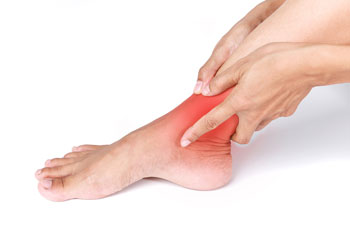
The ankle is a hinged, flexible joint that connects the leg bones, the fibula and tibula, with the foot bone, the talus. It is bound and supported by several ligaments and tendons and also contains muscles, nerves and blood vessels. Ankles help us stand and balance ourselves as well as flexing, pointing and rotating the foot and moving it from side to side.
The ankle is a hard-working joint that bears up to 13 times a person’s body weight and is in constant engagement while walking, running and jumping. For these reasons, the ankle can be prone to pain from an injury or other conditions.
Common Injuries of the Ankle:
Common injuries of the ankle are sprains, strains and fractures.
Ankle sprains occur when one or more of the strong ligaments in the ankle become overly stretched or torn by rolling out of normal position. You may experience symptoms ranging from pain and swelling, bruising, limited ability or the inability to walk, and you may even hear a popping sound at the moment of injury.
Ankle strains are similar but the injury occurs in muscles in the ankle.
Ankle fractures are breaks in one or more ankle bones that can be mild to severe with symptoms such as immediate pain, throbbing pain, swelling, or bruising. In addition, there can be difficulty or an inability to bear weight, tenderness and in severe cases, deformity.
When tendons get irritated, painful, inflamed or torn, this is an injury known as tendonitis.
Arthritic Conditions That Cause Ankle Pain:
Medical conditions that can cause ankle pain include several types of arthritis which cause cartilage and eventually bones to wear down. These forms of arthritis typically include:
Osteoarthritis
Rheumatoid arthritis
Psoriatic arthritis
Gout
Diagnosing and Treating Heel Pain:
To properly diagnose the cause of ankle pain, a podiatrist will examine you and may refer to imaging test such as an X-ray, CT or MRI scan, or a biopsy if an infection is suspected.
The type of treatment a podiatrist will use to treat ankle pain depends on the cause and severity of the condition. These treatments may include
The RICE Method - Rice/Ice/Compression/Elevation
Nonsteroidal anti-inflammatory drugs also know as NSAIDs
Braces and splints
Physical therapy
Joint aspiration
Steroid injections
Orthotics
Surgery
If you are having any type of pain or discomfort in your ankles, schedule an appointment with your podiatrist to have your condition properly diagnosed and treated.
